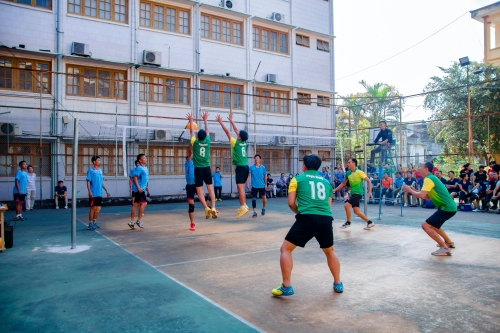Growth of Volleyball Internationally

Volleyball, now one of the most popular team sports worldwide, began humbly in 1895 when William G. Morgan, a YMCA physical education director in Holyoke, Massachusetts, invented it. Initially named “Mintonette,” volleyball was designed to be a mix of basketball, tennis, baseball and handball, providing a less physically intense alternative to basketball.
Over time, the game evolved, and its simple yet dynamic structure allowed it to spread rapidly beyond American borders. The story of volleyball’s growth internationally is one of cultural adaptation, global competitions, and unifying sportsmanship across continents.
The Early Days: Spreading Beyond American Borders
Volleyball began its journey beyond the United States in the early 20th century. The YMCA, which played a crucial role in its invention, also became an essential vehicle for volleyball’s international dissemination. YMCA missionaries and teachers introduced the game to Canada and parts of Asia, and the sport quickly took root. By the early 1900s, volleyball was already being played in countries such as Japan, China and the Philippines.
In Asia, volleyball found early popularity in the Philippines, where players made a significant innovation: the “set and spike” technique. This new way of playing transformed volleyball from a primarily recreational activity into a fast paced and more competitive sport. The growth of volleyball in Asia was just the beginning of its journey to becoming a truly international sport.
Europe’s Embrace of Volleyball
Volleyball’s introduction to Europe was spurred by American soldiers during World War I. The game was taken up by military personnel as a recreational pastime, and it spread quickly among soldiers and local populations. After the war, volleyball remained popular in many European countries, especially in places like France, Italy and the Soviet Union.
In the Soviet Union, volleyball found an enthusiastic audience. The Soviet sports infrastructure embraced the sport and developed structured training programs, transforming it into a highly competitive game. By the 1930s, volleyball was being played at an organized level in several European countries. The formation of regional competitions, particularly in Eastern Europe, helped solidify its popularity.
The Cold War era further boosted volleyball’s development in Europe as it became a point of prestige for competing nations. Eastern bloc countries, including Poland, Czechoslovakia and Romania, invested heavily in the sport and their national teams became dominant forces in international competitions. The European passion for volleyball eventually led to the establishment of professional leagues and a strong grassroots movement that encouraged participation from a young age.
South America: The Rise of Brazil and Beyond
In South America, volleyball gained traction in the 1920s and 1930s, with Brazil leading the charge. Introduced through YMCA activities, volleyball quickly captured the hearts of Brazilians, who loved the sport for its agility, teamwork and accessibility. The sport’s rise in popularity coincided with Brazil’s general embrace of athleticism, helping it spread beyond the urban centers into more rural areas.
Brazil’s dominance in volleyball today can be traced back to the mid 20th century when the country began investing in sports infrastructure and training programs. The success of Brazilian teams in international competitions, particularly since the 1980s, has made the country synonymous with volleyball excellence.
Not only have their men’s and women’s teams won multiple world championships and Olympic medals, but Brazil has also become a hub for beach volleyball, which gained Olympic status in 1996. Argentina and other South American countries also developed strong volleyball cultures, though Brazil has been the undisputed leader on the continent.
Asia: The Establishment of Powerhouses
Volleyball’s growth in Asia was largely influenced by Japan and China. After its introduction, Japan adopted volleyball into its school systems and athletic programs, which laid the foundation for a strong national team. By the 1960s, Japan had become a powerhouse in women’s volleyball, winning gold at the 1964 Tokyo Olympics, which was also the debut of volleyball as an Olympic sport. Japan’s organized approach and disciplined training methods became a model for other countries.
In China, volleyball similarly became an important sport, particularly for women. The Chinese women’s team emerged as a global force in the 1980s, winning multiple world championships and Olympic titles. The sport’s popularity in China was partly influenced by national pride and government support, which saw volleyball as a way to boost international recognition and prestige.
The Asian Volleyball Confederation, formed in 1952, further promoted the sport by organizing competitions across the continent, which encouraged more countries to develop their volleyball programs. Today, countries like South Korea, Thailand and Iran have also made significant strides, contributing to Asia’s prominence in the volleyball world.
Africa: Challenges and Growth
Volleyball reached Africa in the mid 20th century, largely through the influence of colonial powers and international sporting programs. The game initially grew in North African countries like Egypt and Tunisia, where it was adopted by schools and military organizations. Over time, volleyball spread to other regions, although it faced challenges due to limited resources and infrastructure.
Despite these challenges, several African nations have managed to make significant progress in the sport. Egypt, Tunisia and Algeria have consistently fielded competitive teams, especially in regional competitions and the African Volleyball Championship. The Confederation of African Volleyball (CAVB), established in 1972, has been instrumental in promoting the sport by organizing competitions and training programs across the continent.
Efforts by international bodies such as the Fédération Internationale de Volleyball (FIVB) have also helped support African volleyball. Coaching clinics, equipment donations and regional tournaments have contributed to the growth of the sport. While African countries have yet to achieve the same level of success as their counterparts in other continents, there is a strong foundation and the sport continues to grow in popularity and competitiveness.
North America and the Caribbean: Beyond the United States
After its invention in the United States, volleyball spread throughout North America and the Caribbean. Canada adopted the sport in its early days, and it quickly became a popular part of school athletics. The establishment of national federations in Canada and Mexico further supported volleyball’s growth, creating a structure for regional competitions.
In the Caribbean, volleyball found a strong following, especially in nations like Cuba and the Dominican Republic. Cuba, in particular, has been a force in international volleyball since the 1970s, with its women’s team achieving multiple Olympic and World Championship victories. The sport’s popularity in the Caribbean is largely due to its accessibility and the success of regional teams in international competitions.
International Competitions: The Catalyst for Global Popularity
The establishment of international competitions was a major factor in volleyball’s global growth. The formation of the Fédération Internationale de Volleyball (FIVB) in 1947 marked a significant milestone, providing an organizational framework for the sport. The first Men’s World Championship was held in 1949, followed by the Women’s World Championship in 1952. These events helped increase the sport’s visibility and inspired many countries to develop national teams.
The inclusion of volleyball in the 1964 Tokyo Olympics was a watershed moment. Being part of the Olympic program brought volleyball to a global audience and encouraged countries to invest in the sport. The subsequent addition of beach volleyball in the 1996 Atlanta Olympics further expanded volleyball’s reach and popularity, especially in countries with a strong beach culture.
Other international tournaments, such as the Volleyball World Cup, World Grand Prix and Nations League, have also played key roles in popularizing the sport. These competitions provide regular opportunities for countries to compete at the highest level, fostering both a competitive spirit and a sense of community among nations.
The Modern Era: A Truly Global Sport
Today, volleyball is one of the most widely played sports in the world, with an estimated 800 million players globally. The FIVB has 222 member nations, making it one of the largest sporting organizations worldwide. The sport’s appeal lies in its versatility—it can be played indoors, on the beach, or even on grass, making it accessible to a wide range of participants.
Volleyball’s growth has also been aided by the rise of professional leagues around the world. Nations like Italy, Brazil, Russia and Japan have established strong professional leagues that attract top talent and offer a platform for the sport to reach larger audiences. The growth of televised matches and streaming services has further expanded volleyball’s fan base, allowing people from all over the world to watch and appreciate the game.
The international growth of volleyball is a testament to its adaptability and the spirit of sportsmanship it embodies. From its beginnings as a casual game in a YMCA gym to becoming an Olympic sport with a massive global following, volleyball’s journey reflects the power of sports to transcend borders and unite people. Whether played on a beach in Rio, a gym in Tokyo, or a schoolyard in Nairobi, volleyball continues to bring joy and excitement to millions around the world.


